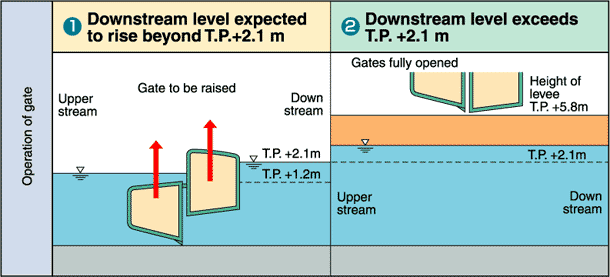Operation During a Storm Surge
During a storm surge, all the gates are raised to a level above the height of the barrage in the same manner as during a flood. In this way, the gates never affect the storm surge.
The operation is switched to the transition mode to storm surge when the river stage in the downstream section rises above T.P. +1.2 m, and when it is expected to exceed T.P. +2.1 m, the gates are fully opened (![]() ). As in the case of floods, this is done without causing sudden changes in the river levels upstream and downstream of the barrage, and the gates are raised above the height of the levee (
). As in the case of floods, this is done without causing sudden changes in the river levels upstream and downstream of the barrage, and the gates are raised above the height of the levee (![]() ).
).
Even when the downstream level is over T.P. +1.2 m, if it is not expected to exceed T.P. +2.1 m, the gates are fully closed to prevent the intrusion of saltwater.
By the end of fiscal 2005, the gates have been fully opened for flood control 73 times since they went into service.

The storm surge caused by Typhoon No. 26 that made landfall on September 29, 1994 before the start of full-scale operation of the barrage reached T.P. +2.23 m with a sea-level difference of 190 cm. These values are the third highest and the fifth highest, respectively, in the postwar period.
During the storm surge caused by Typhoon No. 26, the gates were raised without a hitch and with sufficient time on hand.
The storm surge caused by Typhoon No. 23 that made landfall on October 20, 2004 after the start of full-scale operation of the barrage was expected to cause the water level downstream of the barrage to exceed T.P. + 2.1 m. Then, the gates were fully opened to control storm surge for the first time since the start of barrage operation.
*Tide level anomaly: difference between measured tide level and astronomical tide level
| Date | Tide level(T.P.) |
|---|---|
| Sept.1959 | 3.89m |
| Sept.1972 | 2.53m |
| Sept.1994 | 2.23m |
| Sept.1979 | 2.09m |
| Sept.1953 | 2.06m |
| Date | Tide level anomary |
|---|---|
| Sept.1959 | 3.55m |
| Sept.1961 | 2.00m |
| Sept.1972 | 2.00m |
| Sept.1990 | 1.96m |
| Sept.1994 | 1.90m |